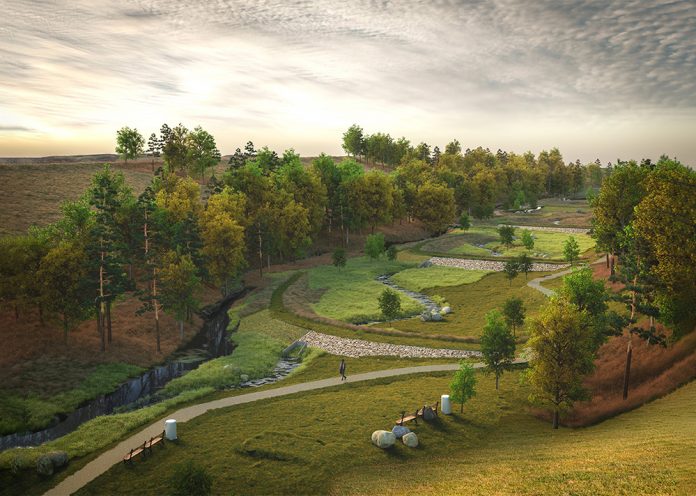Climate change is putting pressure on UK infrastructure with up to eight million properties in England at high risk of flooding by 2050. A collaborative effort is required to prepare for, withstand, and recover from extreme weather events, says Will McBain, Director for Flood Resilience and Adaptation at Arup.
The narrative is shifting from ‘risk management’ by individual operators to collaborative ‘whole of society’ resilience.
But to build resilience we first need to adapt.
Nature – friend or foe?
The nation’s flood defences have evolved over hundreds of years and can be challenging to maintain. Programmes of visual inspection ensure that any outward signs of deterioration are detected, but nature takes its toll on assets and a changing climate, with greater extremes of wet and dry, hot and cold weather, can accelerate the deterioration.
Remote sensing and digital technology are increasingly used to review asset condition and inform detailed inspection and intrusive ground investigation work. This field is ripe for innovation and Arup has collaborated extensively with Environment Agency teams and our supply chain to exploit new technologies in data capture, insight generation and automation.
Increasingly we need to make nature our friend. Smarter strategies will slow water’s journey through landscapes, creating natural storage areas, and restoring floodplains. For coastal flooding, designing waterfronts that absorb wave energy, ideally using nature-based solutions, will be imperative.
Arup’s work on projects like Stronger Shores, funded by Defra’s Flood Risk Innovation Fund, explores the possibilities.
Planners have the best opportunity to make nature our friend when considering new developments. As we embark on a major house building programme, planning decisions need to ‘make space for water’.
‘Designing with water’ (DWW) has long been an Arup mantra. In the context of flood resilience, this means developing designs that make developments safe from flooding over their lifetimes, whilst reducing flood risk elsewhere, in ways that replicate natural hydrological processes.
And this DWW philosophy has been given renewed focus by the Ofwat Innovation Fund project, Enabling Water Smart Communities, with which Arup has been heavily involved. Water smart communities will make nature a firm friend by using water as a valuable resource rather than managing it as a waste product.
The Mansfield Sustainable Flood Resilience Project is a strong example of this principle in an urban setting.
A total of 58,000m3 of stormwater is captured by sustainable drainage systems, including rain gardens and landscaped basins, for slow release. This has a beneficial impact on biodiversity and public realm amenity.
Keeping water closer to source
Water management experts consistently advocate controlling floods at source – intercepting and slowing water in upland catchment areas. Our design for the Environment Agency’s flood alleviation scheme at Skipton in the Yorkshire Dales exemplifies this approach.
The solution uses strategically placed out-of-town storage areas to hold back 130m gallons of water before they enter the town; releasing it once flood risks subside.
Over the past decade, we have conducted extensive studies into the potential of distributed, small scale landscape features designed to capture water at source.
Our NatureInsight software tool – a collaboration with Scalgo – combines comprehensive mapping across Great Britain with nature-based solutions expertise to identify the optimal placement of interventions with insights into the costs and benefits.
Community resilience
We ultimately need ‘whole of society’ resilience, enabling communities to prepare, absorb, recover, and adapt to adverse events.
For residential properties in particularly high-risk areas, Arup has advocated establishing minimum resilience standards, using public funding allocated by cost-effectiveness analysis.
In locations where properties experience very frequent flooding, and large infrastructure solutions are not viable, options beyond basic resistance measures should be available, including voluntary property purchase programmes or ‘retrofit for resilience’.
Flood defence assets will remain a cornerstone of our national flood resilience strategy. To maximise their benefits, designers need to be mindful of local heritage and to seek opportunities to enhance public spaces and increase biodiversity.
Projects should integrate riverside walkways, improve access to nature, expand active travel networks and transform river frontages into community assets while providing essential protection. We have designed several such projects for the Environment Agency and Natural Resources Wales including Beales Corner on the River Severn at Bewdley and Brighouse Flood Alleviation Scheme in Calderdale.
The funding formula
Building genuine flood resilience requires coordinated action bringing together local authorities, water companies, community groups, stakeholders and NGOs. Effective governance frameworks are essential but must avoid becoming bureaucratic obstacles – balancing strategic coordination with meaningful community involvement in decision-making processes.
The current funding formula for flood management in England urgently needs reform to allow more efficient prioritisation of projects and reduce the excessive cost, complexity and timescales associated with capital scheme development.
In our view, particular attention should be given to streamlining processes for ‘no regrets’ capital maintenance expenditure and simplifying justification requirements for low-cost nature-based interventions that address urban surface water issues and Flood Management schemes on smaller rivers affecting towns and villages.
Digital tools shaping flood management
Digital innovations are transforming how we predict, monitor, and respond to flooding in the UK. Advanced systems like FloodAI, which Arup is developing with Northumberland County Council, the Environment Agency and others, can analyse weather radar and issue warnings before rain falls, giving communities precious additional time to prepare.
Modelling technologies are also transforming how we plan and design flood defences. Digital twins and 3D modelling tools allow designers to test different scenarios and solutions virtually before implementation and help communities visualise proposed changes.
Building for the future
In a world rapidly reshaped by climate change, addressing flooding demands a shift toward thoughtful, innovative approaches. We must create space for strategic planning that prioritises passive solutions which enhance local places. The evidence increasingly suggests that well-researched resilience strategies will comprise a portfolio of measures to build social capital locally and enable true ‘whole of society’ resilience.




